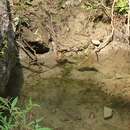Description
provided by AmphibiaWeb articles
The species authority described one male, four females, and four juveniles. The male holotype had a body length of 41 mm, and no female body lengths were listed. The foot webbing extends to the toe tips. The body is medium size, with a mean body length of 54.5 mm. The tibia is long, the callus internus is short and of medium height, and the digitus primus is moderately sized. Males have paired external lateral vocal sacs (Beerli et al. 1994). Pelophylax cerigensis is part of the western Palearctic water frog group, which is differentiated from the Palearctic brown frog group by its extensive foot webbing, males’ external lateral vocal sacs, mottling on inner thighs, and absence of a black face mask. In contrast to the calls of Pelophylax cretensis, the calls of Pelophylax cerigensis do not have amplitude subdivision beyond pulse groups (Beerli et al. 1994).Dorsally, Pelophylax cerigensis is light brown or olive, and may have brown spots. There is no vertebral stripe, and the venter is creamy with mottled gray. The males have gray vocal sacs (Beerli et al. 1994).The species authority is: Beerli P, Hotz H, Tunner H, Heppich S, and Uzzell T. (1994). ''Two new water frog species from the Aegean islands Crete and Karpathos. (Amphibia, Salientia, Ranidae).'' Notulae Naturae, 470, 1-9.The Crete water frogs diverged from other western Palearctic frogs anywhere from five to six million years ago. Karpathos frogs diverged from Anatolian frogs around three million years ago. These dates were obtained through genetic protein electrophoresis data. Pelophylax cerigensis is sister to Pelophylax bedriagae in both genetic (allelic differences at only 2 of 31 loci) and geographic distance (Beerli et al. 1994). The species epithet “cerigensis” comes from Cerigo, which is a Latin name for Karpathos. Pelophylax cerigensis is the only water frog on Karpathos (Beerli et al. 1994). Pelophylax cerigensis was previously named Rana cerigensis (Beerli et al. 1994).(image, http://amphibiaweb.org/images/amazing/amazing_logo.jpg) Featured in Amazing Amphibians on 17 June 2013 (http://amphibiaweb.org/amazing_amphibians/20130617_Pelophylax_cerigensis.html)
- Beerli P, Hotz H, Tunner H, Heppich S, and Uzzell T. (1994). ''Two new water frog species from the Aegean islands Crete and Karpathos. (Amphibia, Salientia, Ranidae).'' Notulae Naturae, 470, 1-9.
- Beerli P, Uzzell T, Lymberakis P. (2009). ''Pelophylax cerigensis.'' The IUCN Red List of Threatened Species http://dx.doi.org/10.2305/IUCN.UK.2009.RLTS.T58567A11787309.en. Downloaded in January 2017
Distribution and Habitat
provided by AmphibiaWeb articles
Pelophylax cerigensis is found in Karpathos, Greece (and possibly also in Rhodes), at elevations around 300 m (Beerli et al. 1994). Pelophylax cerigensis is only known with certainty from a single river on northern Karpathos Island. The mountainous river is near Olimbos. The required habitat is still or slow-moving waters where mating and larval development occur (Beerli et al. 2009).
Life History, Abundance, Activity, and Special Behaviors
provided by AmphibiaWeb articles
Males make advertisement calls that last for around 341 milliseconds (with an standard deviation of 44 milliseconds) and have short intercall intervals of around 276 milliseconds (standard deviation of 54 milliseconds). The calls have approximately six pulse groups (standard deviation of 0.09), each lasting close to 57 milliseconds (standard deviation of 5 milliseconds) and having intervals of around 41 milliseconds (standard deviation of 15 milliseconds). Each pulse group contains over 100 pulses. Vocal recordings were made at a water temperature of 20 degrees C and an air temperature of 18 degrees C (Beerli et al. 1994).
Life History, Abundance, Activity, and Special Behaviors
provided by AmphibiaWeb articles
Modest populations of frogs on Karpathos face threats from scarcity of surface water, deforestation, and degradation of aquatic habitat caused by humans (Beerli et al. 1994). Degradation and loss of aquatic habitat remain the most immediate threats. Although the main habitat area is fairly removed, it faces water abstraction, climate change, and fires. IUCN lists Pelophylax cerigensis as "Critically Endangered" due to its severely limited area of occurrence (less than 100 km2) and area of occupancy (less than 10 km2). The only location from which it is known continues to face habitat loss and habitat quality decline. The current population is believed to be declining, but is not severely fragmented (Beerli et al. 2009).
Distribution in Greece
provided by EOL authors
Distribution in Greece:
Endemic: Karpathos, Rhodes.
General Information
provided by EOL authors
General information:
Total length up to 7cm. Diurnal, shy frog that usually basks out of water. It will jump into the water when it feels threatened. It feeds mainly on invertebrates. It mates in spring and females lay their eggs in the water in clusters of a few hundred. Faces a high risk of extinction and it is classified as "Critically Endangered" in the red list of IUCN.
Karpathos frog: Brief Summary
provided by wikipedia EN
The Karpathos frog (Pelophylax cerigensis) is a species of frog in the family Ranidae. It is endemic to the island of Karpathos, South Aegean Sea, Greece. The Karpathos frog is considered the most endangered anuran amphibian in Europe because its range is restricted to two small rivers in the north part of the island.
Its natural habitats are Mediterranean-type shrubby vegetation, rivers, intermittent rivers, freshwater lakes, intermittent freshwater lakes, freshwater marshes, intermittent freshwater marshes, arable land and ponds. It is threatened by habitat loss.
- license
- cc-by-sa-3.0
- copyright
- Wikipedia authors and editors

